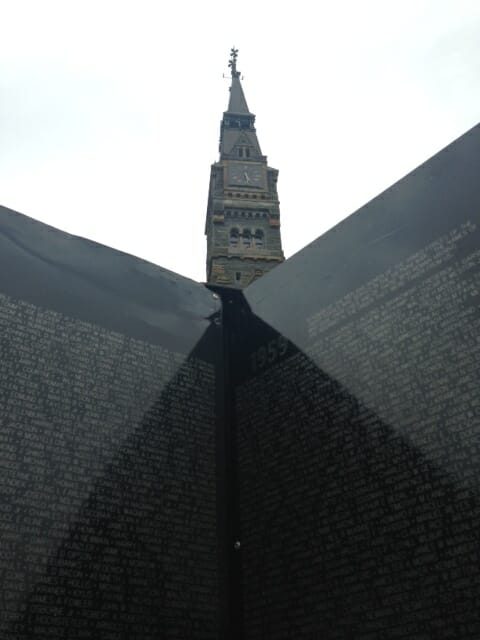Does D.C. Repeat Itself? Very Well Then, It Repeats Itself

The nation’s capital has been all but overtaken by blurry, doubled vision. At the Phillips Collection, one of the few museums open during the partial government shutdown, there is, starting this month, an exhibit of Vincent van Gogh’s repetitions, thirty-five repeated studies of thirteen different subjects. The exhibit, conveniently christened Repetitions, is both unique—this is the first time the artist’s repetitions have been gathered together in an exhibit—and yet another study in the copycat aesthetic that characterizes Washington.
The exhibit was inspired by two paintings by the Dutch master, The Road Menders (part of the Phillips Collection) and The Large Plane Trees (which belongs to the Cleveland Museum of Art).
Both were painted in 1889, and both disclose the same scene. And yet the differences between the two—color, texture, detail—are striking, exhilarating precisely because they reveal the skill and eye of a well-known artist in an entirely new way. Van Gogh is no longer reduced to sunflowers or starry nights taped to college dorm room walls. Instead, he is once again the devoted craftsman. Why do a woman’s hands become bent and jagged when repainted? Why does a postman’s beard morph and move through space? Everything changes in the retelling.
Elsewhere in Washington, another imperfect copy has been put on display, tucked away on Georgetown University’s campus. The Vietnam Veterans Memorial, like much of the rest of the national mall, has been officially shuttered since October 1. In response to this closing, Georgetown and the Vietnam Veterans Memorial Fund came together to keep the Vietnam memorial “open.” Unlike the World War II veterans, Vietnam vets did not storm their memorial’s barricades. Tea Party lawmakers and conservative ex-governors didn’t skip down to the memorial in order to protest too much. Rather, Georgetown and the VVMF erected a 250-foot replica of the memorial wall, usually on tour around the country, on Georgetown’s campus, and have offered shuttle rides from the national mall to the replica. The replica is, of course, an imperfect copy of the austere black marble original: it is “power-coated aluminum” and “twenty-four panels with six columns of the names printed down each.”
This repetition is revealing because of its close proximity to the original—this is a replica that has found its purpose by being far enough from the original to serve as therapy for damaged veterans and a proxy for the capital. And there’s something provocative about this replica being erected at the university that employed Henry Kissinger, former secretary of state and champion of the Vietnam War and the secret bombings of Cambodia. This is the university that schooled president Bill Clinton, who was shaped by the Vietnam era, and that employed the current secretary of defense Chuck Hagel. This is the place that schooled, employed, and fired Douglas Feith, one of the architects of the second Iraq war. There is something decidedly appropriate about the idea that the memorial erected on this campus in the memory of those fallen in battle should be a replica. In this context, the aluminum copy is better understood, perhaps, as a fake.
Across town, federal Washington—at least the part where national politics, legislation, and regulation are made—makes a practice of luxuriating in this same kind of repetition. The same bills come up year in and year out; the same arguments are pared down, spun up, and spat out to television cameras; the same brinksmanship seems to nearly destroy the country. Politicians shout from behind lecterns that they will change Washington, once and for all, while reporters crack the same cynical jokes in response. The cherry blossoms bloom and wilt, while tourists swing from the tree branches and locals scream at them to stop.
For the past several years, the Groundhog Day feeling of Washington’s politics has heightened to the point of hysterical record skip. On the eve of the debt-ceiling deadline—October’s latest man-made disaster—Americans can’t help but notice that this current disaster is an imperfect copy of previous debt-ceiling disasters past. The crisis follows the partial government shutdown disaster of earlier this month, another inexact replica of the shutdown disaster of 1990s. The flames of these crises are being stoked by the rhetoric of the health care debate, which is in itself a master class in Washington’s repetition fetish.
Except even in this, Washington’s repetitions are never perfect carbon copies, because there is no such thing as a perfect man-made replica, especially when it comes to human interaction. The act of repeating anything, an image or a memorial or law, invites and tempts change or perversion with each iteration. The thing that is being repeated morphs a bit each time it is copied, revealing what has been obscured about the subject being copied and the thing carrying out the copying.
Be aware of the details that our powerful keep harping on and the language that they keep reconstructing. Like the pharaohs of long past, they are yet another group who can only communicate through obfuscation and symbol.